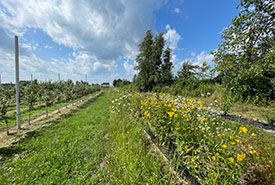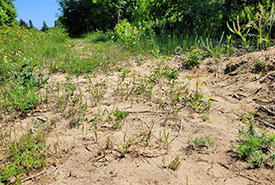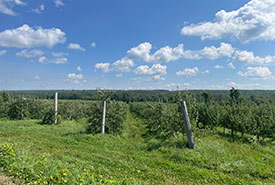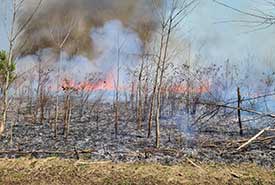NCC: Land Lines – Nature-friendly practices that benefit wildlife and plants

Orchard (Photo by NCC)
My name is Gabrielle and I’m a biologist. I’m currently completing my master’s degree in environment and sustainable development, biodiversity management at the Université de Montréal. I’ve always been interested in ecological connectivity and the reconciliation between nature and society.
This summer, I was lucky enough to be a conservation intern with the Nature Conservancy of Canada in the Montérégie region of Quebec.

Forked three-awned grass, a plant that grows in sandy deposits (Photo by NCC)
I was able to work on several projects in the southern part of the province, including a restoration project for forked three-awned grass, a plant that grows in sandy deposits — a rare habitat type in Quebec. This unique experience allowed me to work with a threatened species and help implement a restoration plan for it.
I also drafted an owners’ booklet for orchard producers in the Covey Hill region. The producers we’ve worked with have all shown a keen interest in our advice.
The booklets contain advice on the various agri-responsible practices that can be implemented in orchards, including ones on floristic and wildlife management.

Views from the orchard (Photo by NCC)
We have recommended three types of floristic landscaping: windbreaks, which help reduce wind pressure on crops and limit pesticide drift; flower strips or islands, which serve as a refuge for pollinators and other crop allies (insects such as ladybugs); and riparian buffers, which protect against erosion and filter sediments, fertilizers and pesticides to prevent them from entering the aquatic environment.
In terms of wildlife habitat features, NCC proposes three habitat features that encourage the presence of animals that can help control crop pest populations.
- Bird nesting boxes and perches, which encourage the presence of birds of prey and insectivorous birds;
- Snake hibernacula, a discreet feature that attracts these lesser-known reptiles in Quebec, yet are essential for maintaining the food chain; and
- Bat box, which provide shelter for these insectivores whose populations are in serious decline.
I was impressed by the willingness of some producers to adopt these practices. I believe that our ability to develop and promote features that benefit both the environment and crops is vital for the future of agriculture.
Some features are less popular with producers: bat box and snake hibernacula. Socially speaking, these are less charismatic species and do not have a good reputation among the general public. There’s still a lot of work to be done for the acceptance of these species, which are nonetheless excellent allies to have in our crops.
I learned a lot during my internship. If I had to emphasize one thing, it would be the importance of teamwork. Cooperation between biologists, but also with agronomists and producers, is essential in developing good relationships and enabling a better understanding of agri-environmental issues. Communication is key.




